Newly discovered Comet Nishimura is quickly brightening in the morning sky and may be faintly visible with the naked eye next month. On August 24th observers in North America will be treated to an occultation of Antares.
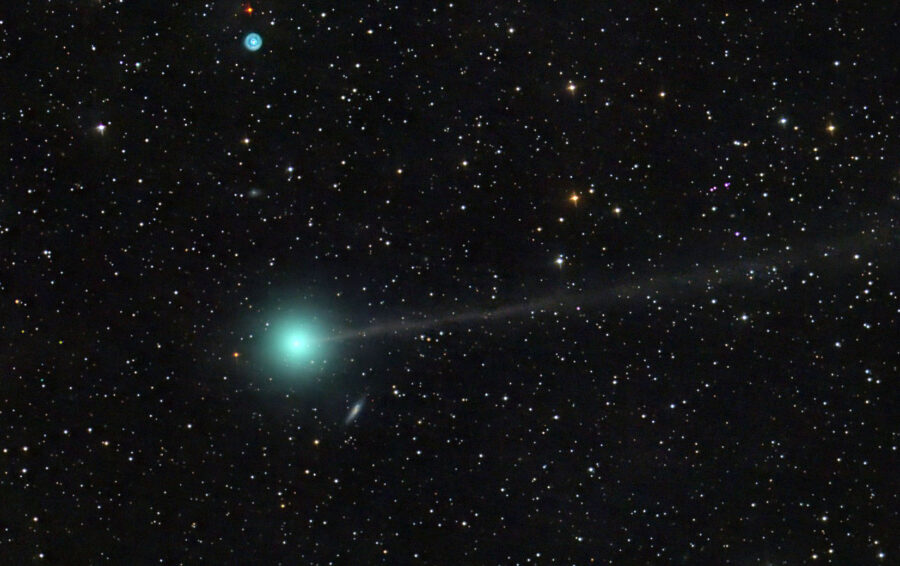
Dan Bartlett
It's no small thing for an amateur to wrest a comet from the all-seeing eyes of robotic surveys. But Japanese observer Hideo Nishimura beat those odds on August 12.8 UT. That morning he took three 30-second exposures with a Canon 6D digital camera and 200-mm lens and captured images of a new 11th-magnitude comet in the constellation Gemini. It was his third comet discovery after Comet Nakamura-Nishimura-Machholz (C/1994 N1) and an earlier Comet Nishimura (C/2021 O1). I have nothing against automated hunting, but seeing an amateur's name on a comet is not only a breath of fresh air but a great achievement.

Courtesy of H. Nishimura
Comets are like presents under the Christmas tree waiting to be opened. On August 15th the sky cleared and I found a location with an unobstructed view to the east to get my first look. At 4 a.m. local time Comet Nishimura stood just 8° high in the northeastern sky in Gemini. Through my 15-inch (38-cm) Dob I saw it right away at 64× at magnitude 9.8 with a 2.3′ moderately condensed coma. A Swan band filter enhanced its visibility and intensified the apparent brightness of the inner coma, a sign that Nishimura's comet was rich in volatile carbon gas.
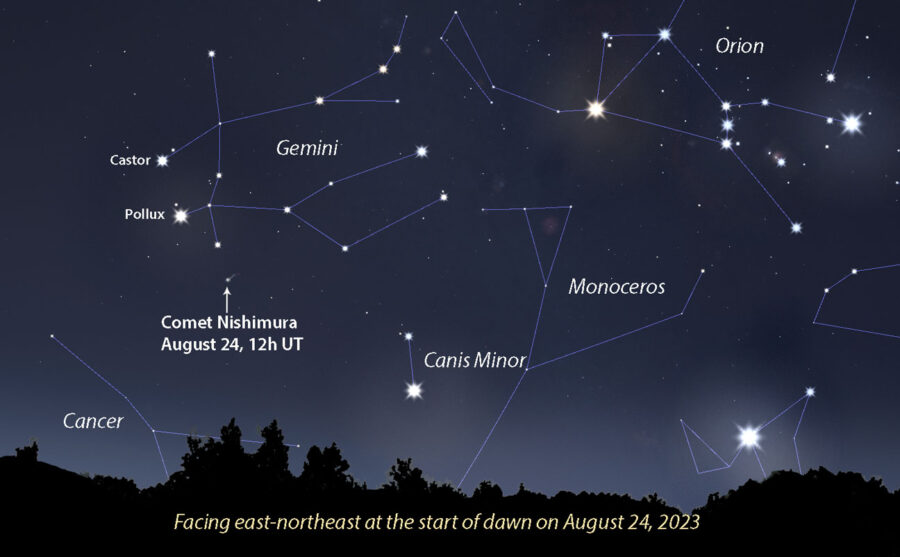
Stellarium with additions by Bob King
Since then the comet's magnitude has brightened to about 8.5 with binocular sightings becoming increasingly more common. Nishimura should top out around 4th magnitude before the solar glare claims it. The bad news is that its altitude will be rather low throughout its apparition and decrease as the comet approaches perihelion on September 18th. Crucial to spotting the new object will be an unobstructed view to the east-northeast. Across the continental U.S. the comet will stand about 15° high just before the start of astronomical twilight for the next two weeks. Currently, twilight begins in the northern part of the country about 1 hour 50 minutes before sunrise and 1 hour 20 minutes before sunrise in the southern U.S.
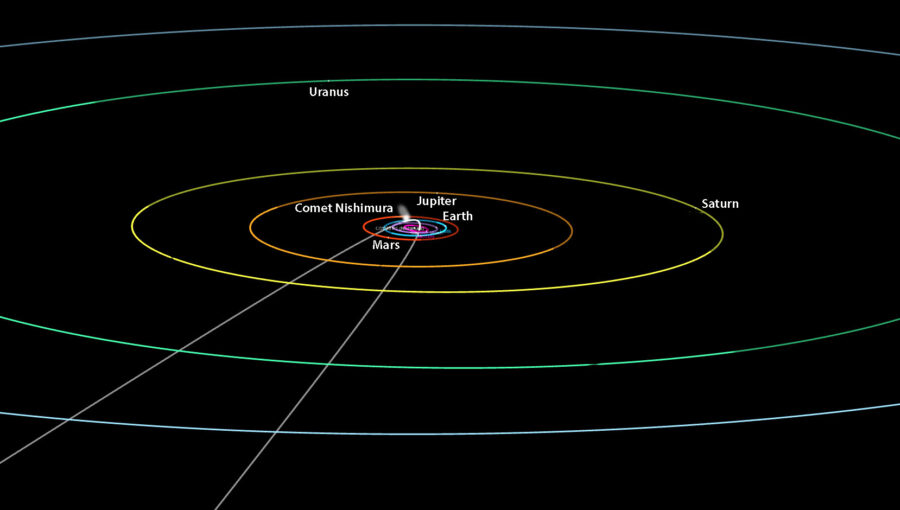
JPL-Horizons
After about September 5th, the comet's rapidly decreasing solar elongation chips away at its elevation. By the time it's within naked-eye range it will stand just a few degrees high at the start of dawn. For example, we'll see Nishimura about 10° above the horizon on September 5th; 6° on September 8th; and just 2° high on September 10th. Given that the comet will brighten from about magnitude 5 to 4 during this time it should still remain visible with binoculars. Northern Hemisphere observers will likely get their last looks on or close to September 13th.
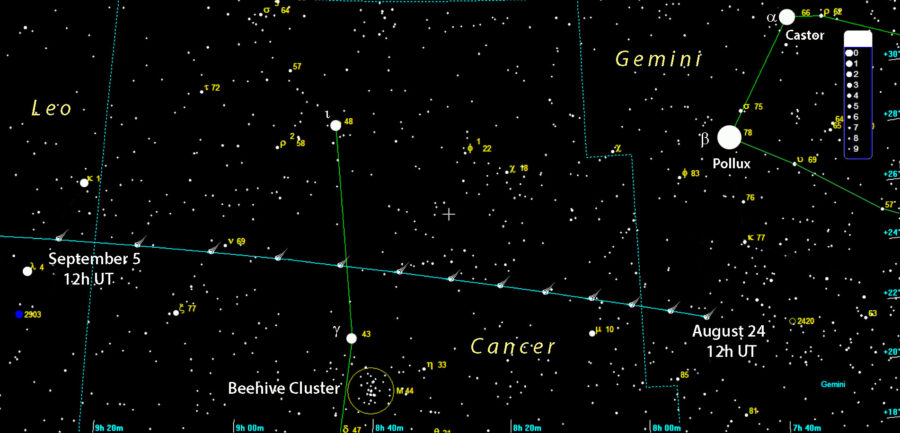
MegaStar courtesy of Emil Bonanno with additions by Bob King
Through the end of August a 4-inch telescope should be adequate to track down our temporary guest. In September 50-mm binoculars may do the trick but I'd still keep a scope handy to explore details of the inner coma, pseudo-nucleus, and better appreciate the character and extent of the tail. Astrophotographers will have opportunities to capture nice views of the comet paired with the Beehive Cluster (M44) in Cancer on and around August 31st and the 9th-magnitude galaxy NGC 2903 in Leo on September 5th.
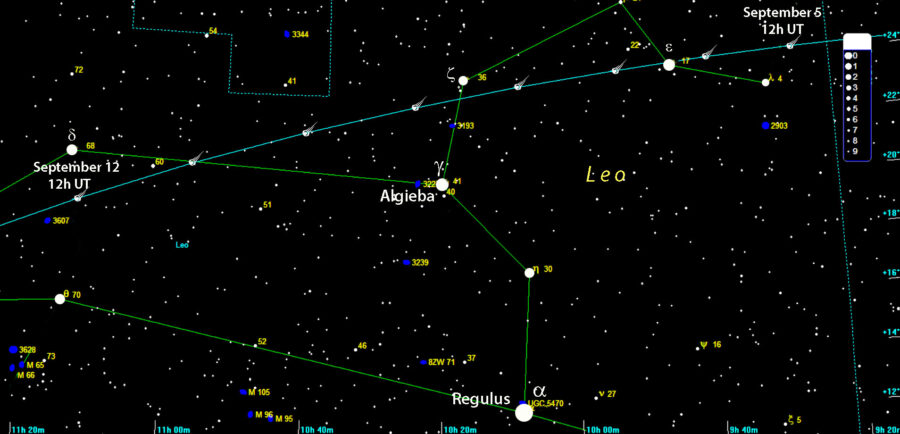
MegaStar by Emil Bonanno with additions by Bob King
Its perihelion will be a scorcher with the comet passing just 0.2 a.u. (30 million kilometers) from the Sun, well inside Mercury's orbit. There's a fair chance this first-time visitor from the Oort Cloud may not survive the brush and fall to pieces. But if it can keep itself together the fragile mess will swing into the evening sky in Virgo after perihelion. Mid-northern latitude observers will lose the comet to glare and low altitude, but prospects are more sanguine for the Southern Hemisphere where it will appear very low in the western sky at dusk through month's end. Catch it soon before it fades.

Oliver Schneider
Given the ubiquity of wildfire smoke I encourage everyone with good skies to share their observations in the comments section so other readers can keep track of developments. You'll also find current information about the comet on Seiichi Yoshida's Weekly Bright Comets and the Comet Observation database (COBS).
Heads up! Antares occultation
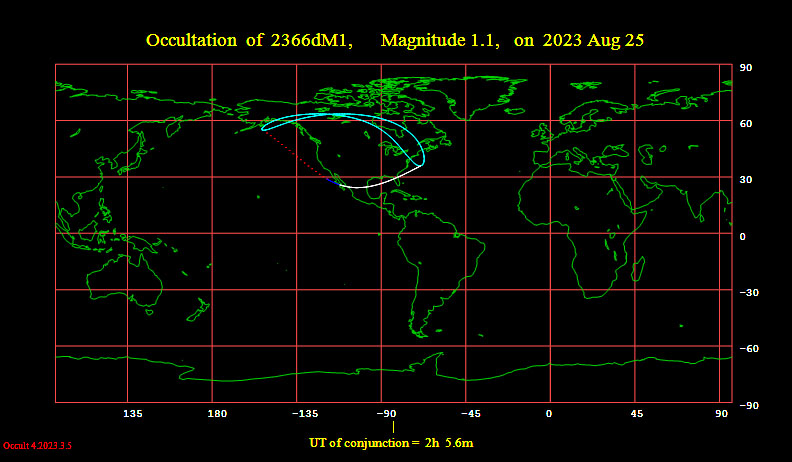
Occult 4
On August 24th, for the first time since February 2010, the Moon will occult the 1st-magnitude star Antares in Scorpius. Observers from the East Coast (except most of Florida) to the mountain states will see the waxing gibbous Moon slowly approach and then suddenly cover the star during early evening viewing hours. The visibility zone also includes much of Canada and a portion of Mexico.
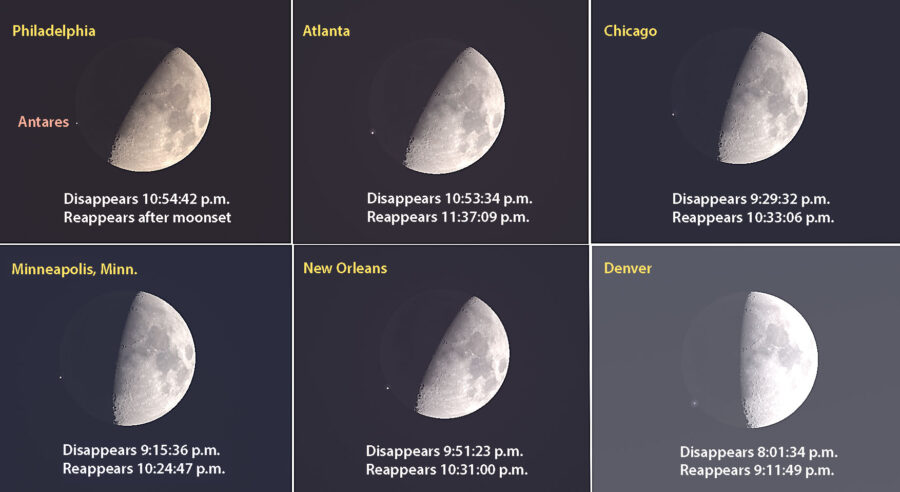
Stellarium
From locations in the central U.S. both the star's disappearance at the Moon's dark limb and reappearance at the bright limb will be visible. To find out your viewing prospects, go to the International Occultation Timing Association's (IOTA) page devoted to the event and look up your city. Times shown are Universal Time. To convert to EDT subtract 4 hours; 5 hours for CDT; 6 hours for MDT; and 7 hours for PDT.
Antares is a close double star with a 5.4-magnitude companion 2.7″ away in P.A. (position angle) 277°. Notoriously difficult to split, the Moon won't offer any help this time around because it first occults the secondary followed by the bright primary. Although the secondary star reappears at the opposite limb moments before the glary primary, light from the bright limb may mask it from view. Give it a try anyway — I'd love to hear if you spot it both coming and going. For those keeping track, the August 24th Antares occultation is the first in a series that will end on August 27, 2028.
 15
15









Comments
Joe Stieber
August 24, 2023 at 7:43 pm
I've seen C/2023 P1 (Nishimura) on two mornings so far, August 19 & 23, 2023, each time from the dark New Jersy Pinelands. For August, both mornings were atypically clear and cool (temperatures were in the mid-50°F range). Both times I used my 115 mm (4.5 inch) spotting scope on a manual altazimuth mount. On Aug 19, I spotted P1 20 min before the start of astronomical twilight (4:34 am EDT) and followed it until 31 min after; on Aug 23, P1 was seen from 38 min before until 37 min after the start of twilight (4:40 am). At first, the comet was dimmed by the thick atmosphere around 8° altitude, but as it rose out of that, twilight ultimately took its toll. The first 10 to 15 minutes after the start of twilight seemed to yield the best view. On Aug 19, I was able to glimpse it with 15x56 binoculars in that "prime time," and on Aug 23, I had a solid sighting with the binoculars. Unfortunately, we're now under a thick cloud cover in the South Jersey area, so it doesn't look like we'll get to see tonight's Antares occultation, or the Falcon 9 launch as it travels along the East Coast taking Crew-7 to the ISS, currently scheduled for Friday morning, Aug 25, around 4 am.
You must be logged in to post a comment.
Bob KingPost Author
August 25, 2023 at 2:26 pm
Joe,
Great to hear you've already seen the comet in binoculars! I'm chomping at the bit here waiting for clouds and smoke to clear. My last and first observation was Aug. 15. The comet is currently around magnitude 8 — a nice steady rise.
You must be logged in to post a comment.
Tom Hoffelder
August 25, 2023 at 11:32 am
After seeing the rather sensational (as usual) mainstream media reports, not to mention ones by the many wannabe "science" websites, I knew further investigation was required since none of them mentioned anything about how close 2023 P1 would be to the Sun when at naked eye brightness. That is why your title is the best! "MAY BECOME NAKED-EYE BRIGHT" is NOT the same as "will be visible to the naked eye next month" (LIVESCIENCE) or, worse, "New Naked Eye Comet Could Soon Light-Up The Night Sky" (Forbes).
Whenever a comet makes international news, the first thing I do is go to two of Seiichi Yoshida's pages, the one you listed and http://www.aerith.net/comet/weekly/current.html. For Sept, the latter shows the comet being 4th mag at a max altitude of 13 degrees, but I don't know which twilight (astro or nautical) he uses for that. On the other page, he simply says "It will be unobservable in September." It obviously will be somewhat observable, more or less, early in Sept, but I take that to mean he does not expect it to be naked-eye due to an elongation of less than 15 degrees after the 12th.
As with Seiichi's twilight, I am wondering what you are calling dawn, the beginning of astronomical, nautical or civil twilight? When using Stellarium to determine when would be the best time for me to observe it, I checked both the beginning of astro and nautical twilight. I decided based on predicted magnitude(s) - I have seen three ranging from 3.3 to 1 - that it will not be naked-eye for me, unless it breaks apart like West did, which will be the thing to monitor.
My wife and I were able to easily observe Comet Nishimura (to me the most amazing thing about it is having a person's name!) yesterday morning in her 8" f/6 Newtonian at 50X. The altitude was 15 degrees at 04:25 EDT, which was 25 minutes after the beginning of astronomical twilight.
You must be logged in to post a comment.
Bob KingPost Author
August 25, 2023 at 2:25 pm
Hi Tom,
Thanks for your note. Much appreciated. When I refer to twilight I mean the beginning of astronomical twilight which occurs now (depending on latitude) about 1 hour 50 minutes (northern U.S.) to 1 hour 20 minutes (southern U.S.) before sunrise. As the comet brightens it will absolutely be visible into twilight so I'm not surprised at you and your wife's observation. I chose the start of morning twilight as a conservative limit to keep expectations reasonable.
You must be logged in to post a comment.
Andrew
August 25, 2023 at 4:57 pm
I saw the incredibly bright and blazing Antares "reappear" from behind the moon on August 24th from Riverside, CA. The sight had me waiting with high anticipation counting the seconds until reappearance at exactly 19:42pm (Pacific).
I used 25x100 Oberwerk Binoculars and a large parallelogram Binocular mount and Heavy Duty tripod. The view was stunning in binoculars. It was like a shiny diamond was "released" from behind the moon. So odd to see this bright star slowly move away from the limb of the moony rising above Vallis Rheita.
I went out early this morning to look for Comet Nishimura, but did not succeed with handheld bino's in the bright skies. I'll try again tomorrow with a telescope. Still good clear skies from Southern California to view this new comet.
You must be logged in to post a comment.
Bob KingPost Author
August 25, 2023 at 6:16 pm
Andrew,
Thank you for sharing your enthusiastic report of the reappearance of Antares. I observed both the disappearance and reappearance and have to say the latter was equally if not more impressive. How quickly it "rose" from the moon's limb!
You must be logged in to post a comment.
Dobsonite
August 26, 2023 at 2:21 am
Missed the Antares event-earthly things had my attention. But boy, I sure wish I was living in the outback again. Here in the city, we can only see the planets on a good night, and, of course, the Moon. You guys and gals don't know how lucky you are! 🙁
You must be logged in to post a comment.
OwlEye
August 27, 2023 at 10:50 am
Hi Bob,
Thanks for this great article!
I had my first chance to get out north of Topeka this morning to have a look at Comet Nishimura. Picked it up easily at 5:00 am local time (~ 10 minutes before the beginning of astronomical twilight), 13 degrees above the ENE horizon with a 6-inch reflector at 31 X. Appeared to be ~ magnitude 7.5 with a coma diameter of 1.8 arcmin.
The comet was also easily seen in a 4.25-inch RFT at 15 X, and after some clouds passed by, I was able to make out its tiny, diffuse glow with a hand-held, 7 X 50 binocular at 5:31 (21 minutes into astro-twilight).
No tail detected with any of these instruments. Need a much darker sky!
Such a beautiful, breezy morning, with Great Horned Owls mourning off to the northwest, and several Barred Owls questioning one another to the east.
DZ
You must be logged in to post a comment.
Bob KingPost Author
September 3, 2023 at 12:12 am
Hi Doug,
Nice to hear from you and thank you for your observation. Sounds like your brought out all the artillery! Fortunately, the moon is waning so visual observers should get to see at least some of this comet's spectacular tail perhaps as soon as early next week (Sept 4,5).
You must be logged in to post a comment.
Richard-Taylor
August 27, 2023 at 9:03 pm
We had an unusually clear sky in Ottawa, Canada this morning (2023-08-27). I set up my equipment (William Optics Z73, ZWO ASI 178MC camera, iOptron HEM27 mount) in the Central Experimental Farm with a good view to the North East. Using your excellent maps, plus Stellarium, I aimed at star HIP 39705 and found the comet nearby. It was easily visible as a greenish fuzzy ball on my laptop screen, but there was only the vaguest hint of a tail. I took about 100 30s exposures with gain 270 (between 4:00 and 5:00 am EDT) and stacked about 80 of them, but still the tail was only barely visible. Thanks for pointing me to this comet.
RPT
You must be logged in to post a comment.
Bob KingPost Author
September 3, 2023 at 12:09 am
Hi Richard,
Thank you for your report. I found the coma bright, very condensed and even blue-tinted in my 15-inch on the morning of Aug. 30 but couldn't confirm a tail. Moonlight was a problem. I did a few exposures with a 200mm and recorded a short, very faint tail. Hopefully, we'll see more as the moon wanes.
You must be logged in to post a comment.
SNH
September 2, 2023 at 11:17 am
I saw the comet this morning in 12x60 binoculars. At the start of astronomical twilight, it was about 13 degrees up and magnitude +6.8 when compared to nearby stars. It's going to have to get another two full magnitudes brighter for me to see it naked-eye I think because it's not very high and the Moon is here to stay in the morning sky. I hope it does. But either way, it's been a real cute one to look at in my 6-inch.
Scott H.
You must be logged in to post a comment.
Bob KingPost Author
September 3, 2023 at 12:07 am
Hi Scott,
I appreciate you sharing your observation. I plan to go out tomorrow morning for another look. Any hint of a tail in either binoculars or your 6-inch?
You must be logged in to post a comment.
SNH
September 7, 2023 at 4:57 pm
Oh, the tails was readily visible as a straight, razor-thin line in the 6-inch before the Moon arrived...but it's been harder to see ever since. However, today I could see the tail had widened in my 6-inch and even detected its presence in my 12x60 binoculars. I estimated it at +5.2 using nearby 22 Leonis.
Scott H.
You must be logged in to post a comment.
Rod
September 6, 2023 at 7:43 am
I did see the comet this morning, report here https://skyandtelescope.org/astronomy-news/observing-news/this-weeks-sky-at-a-glance-september-1-10/#comment-386904
theskylive.com reports 4.9 apparent magnitude now.
You must be logged in to post a comment.
You must be logged in to post a comment.